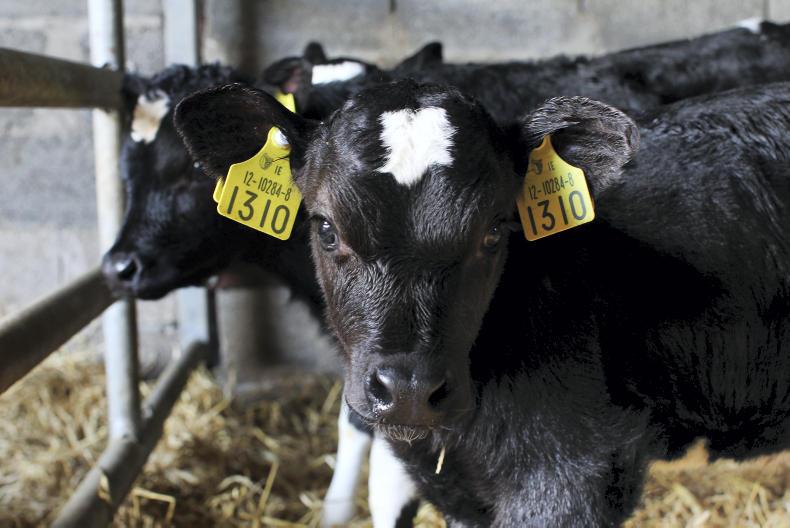Since 2010, dairy births have grown by over 300,000 head, with dairy births forecast to hit over 1.4m head in 2017 and continue to grow. Coupled with a fall-off in live exports of calves in 2016 and a combined reduction of 30,000 head since 2010, there is a sharp increase in the annual kill forecast.
Throughput in 2017 is expected to lift 100,000 more to 1.75m head. It is therefore no surprise that live exports are attracting close attention, with calves currently in the spotlight.
At the recent live export seminar held by Bord Bia, Joe Burke delivered a market forecast on the calf trade with a particular focus on Ireland’s two main markets, the Netherlands and Spain.
Optimistic
Joe said: “Calf exporters at the event were optimistic about the upcoming season but an aspect that they were very clear on is that demand will be confined to calves that suit market demand. For the Netherlands, this is a good Friesian calf (Holstein or British Friesian) weighing between 45kg and 50kg. The type of calf sought in Spain is a better conformed, stronger calf weighing ideally over 55kg.
Commenting on potential demand in our two main markets, Joe said: “The Netherlands is a massive market that has become increasingly integrated. The leading processor, Van Drie, accounts for more than one million head, over 75% of slaughterings annually. Underpinning this trade is Dutch imports of approximately 750,000 calves in 2016. Ireland, however, supplied just 27,000 head, well behind Germany [550,000] and Belgium [50,000].”
The reduction in exports of close to 17,000 head is attributed to a number of factors with increasingly difficult transport regulations highlighted as making it significantly more expensive to export calves there.
[Transport] has come under increasing scrutiny in that market where veterinary regulations and supervision are very important
“[Transport] has come under increasing scrutiny in that market where veterinary regulations and supervision are very important. Dutch authorities implemented a new directive in spring 2016 which requires Irish transporters to make an additional feeding stop within nine hours of departing the resting station in France. The market is happy with Irish calves but it has made exports more expensive.
“The potential of the market in 2017 will be influenced by the cost of calves in the Irish market and potential to return a margin.”
Increased competition from farmers and resultant higher prices in recent years has limited exporter margins and in turn the volume of calves leaving the country.
“The average calf price last year would have been between €90 and €100 for a good-quality Friesian bull calf. There would have been more variation when you take into account the lighter or younger calf and really Ireland had a good year last year exporting that better-quality calf. For example, that three-week-old good-quality Friesian bull calf that’s 50kg or 55kg went to Spain in greater numbers.”
 The Spanish market is seen as offering more potential in 2017, provided the right type of calves are available and prices here are at a level that can justify exporters to operate.
The Spanish market is seen as offering more potential in 2017, provided the right type of calves are available and prices here are at a level that can justify exporters to operate.
“Total live exports to Spain last year were over 42,000. That was up by a third on the previous year and that was mainly made up of good-quality calves, or at least calves that were off to a good start. Where the difficulty has been is maybe what you would call the lower end of the market – the plainer, lighter, younger Friesian bull calf that maybe is struggling a little bit in terms of weight. There is very little that a live exporter can do with a calf that is isn’t, for example, 45kg – they have to be a minimum of 15 days old in order to be exported and that was one of the key messages coming back from the live exporters.”
Burke said that with rising numbers coming on stream from dairy expansion, there will be a greater differential in calf prices.
“That’s going to be the case if it’s a farmer or exporter buying. You want something that’s off to a good start, that’s healthy, that’s going to go ahead for you. Really the message that we would send to dairy farmers in particular that are going to be marketing dairy bull calves this spring would be to encourage them to try and keep them for the 15 days, to look after them well for that period and ideally present at the weight category that’s wanted. Forty-five kilogrammes plus is going to be the minimum of what exporters are going to be looking for.”
Live export regulations
As well as the recommendations above, there are a number of factors to consider. To comply with movement regulations only calves from TB-free herds can be approved for export. Calves cannot be exported live at less than 14 days of age, and must be TB tested if they exceed 42 days of age. Therefore, if aiming for this market, it is important to offer calves at the optimum time to attract maximum demand.
Read more
Focus: calves 2017
Since 2010, dairy births have grown by over 300,000 head, with dairy births forecast to hit over 1.4m head in 2017 and continue to grow. Coupled with a fall-off in live exports of calves in 2016 and a combined reduction of 30,000 head since 2010, there is a sharp increase in the annual kill forecast.
Throughput in 2017 is expected to lift 100,000 more to 1.75m head. It is therefore no surprise that live exports are attracting close attention, with calves currently in the spotlight.
At the recent live export seminar held by Bord Bia, Joe Burke delivered a market forecast on the calf trade with a particular focus on Ireland’s two main markets, the Netherlands and Spain.
Optimistic
Joe said: “Calf exporters at the event were optimistic about the upcoming season but an aspect that they were very clear on is that demand will be confined to calves that suit market demand. For the Netherlands, this is a good Friesian calf (Holstein or British Friesian) weighing between 45kg and 50kg. The type of calf sought in Spain is a better conformed, stronger calf weighing ideally over 55kg.
Commenting on potential demand in our two main markets, Joe said: “The Netherlands is a massive market that has become increasingly integrated. The leading processor, Van Drie, accounts for more than one million head, over 75% of slaughterings annually. Underpinning this trade is Dutch imports of approximately 750,000 calves in 2016. Ireland, however, supplied just 27,000 head, well behind Germany [550,000] and Belgium [50,000].”
The reduction in exports of close to 17,000 head is attributed to a number of factors with increasingly difficult transport regulations highlighted as making it significantly more expensive to export calves there.
[Transport] has come under increasing scrutiny in that market where veterinary regulations and supervision are very important
“[Transport] has come under increasing scrutiny in that market where veterinary regulations and supervision are very important. Dutch authorities implemented a new directive in spring 2016 which requires Irish transporters to make an additional feeding stop within nine hours of departing the resting station in France. The market is happy with Irish calves but it has made exports more expensive.
“The potential of the market in 2017 will be influenced by the cost of calves in the Irish market and potential to return a margin.”
Increased competition from farmers and resultant higher prices in recent years has limited exporter margins and in turn the volume of calves leaving the country.
“The average calf price last year would have been between €90 and €100 for a good-quality Friesian bull calf. There would have been more variation when you take into account the lighter or younger calf and really Ireland had a good year last year exporting that better-quality calf. For example, that three-week-old good-quality Friesian bull calf that’s 50kg or 55kg went to Spain in greater numbers.”
 The Spanish market is seen as offering more potential in 2017, provided the right type of calves are available and prices here are at a level that can justify exporters to operate.
The Spanish market is seen as offering more potential in 2017, provided the right type of calves are available and prices here are at a level that can justify exporters to operate.
“Total live exports to Spain last year were over 42,000. That was up by a third on the previous year and that was mainly made up of good-quality calves, or at least calves that were off to a good start. Where the difficulty has been is maybe what you would call the lower end of the market – the plainer, lighter, younger Friesian bull calf that maybe is struggling a little bit in terms of weight. There is very little that a live exporter can do with a calf that is isn’t, for example, 45kg – they have to be a minimum of 15 days old in order to be exported and that was one of the key messages coming back from the live exporters.”
Burke said that with rising numbers coming on stream from dairy expansion, there will be a greater differential in calf prices.
“That’s going to be the case if it’s a farmer or exporter buying. You want something that’s off to a good start, that’s healthy, that’s going to go ahead for you. Really the message that we would send to dairy farmers in particular that are going to be marketing dairy bull calves this spring would be to encourage them to try and keep them for the 15 days, to look after them well for that period and ideally present at the weight category that’s wanted. Forty-five kilogrammes plus is going to be the minimum of what exporters are going to be looking for.”
Live export regulations
As well as the recommendations above, there are a number of factors to consider. To comply with movement regulations only calves from TB-free herds can be approved for export. Calves cannot be exported live at less than 14 days of age, and must be TB tested if they exceed 42 days of age. Therefore, if aiming for this market, it is important to offer calves at the optimum time to attract maximum demand.
Read more
Focus: calves 2017
 The Spanish market is seen as offering more potential in 2017, provided the right type of calves are available and prices here are at a level that can justify exporters to operate.
The Spanish market is seen as offering more potential in 2017, provided the right type of calves are available and prices here are at a level that can justify exporters to operate. 





 This is a subscriber-only article
This is a subscriber-only article






SHARING OPTIONS: